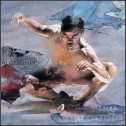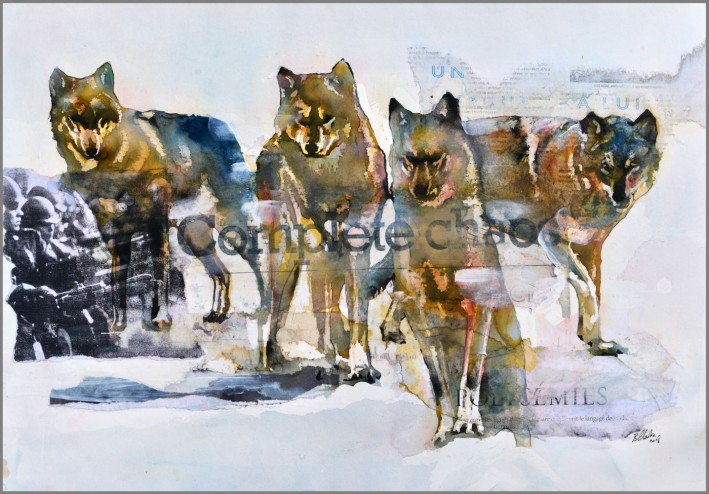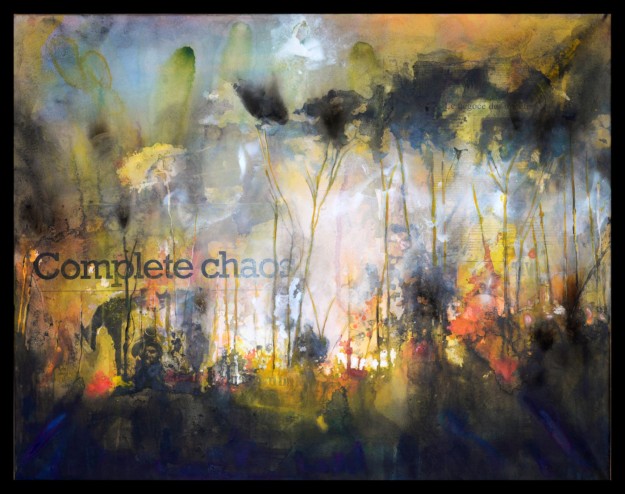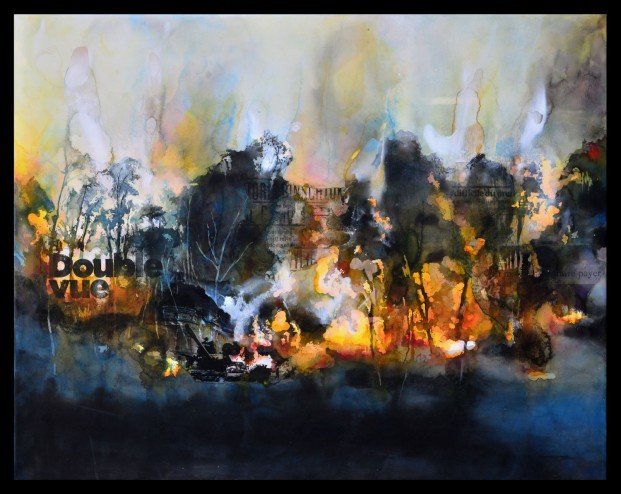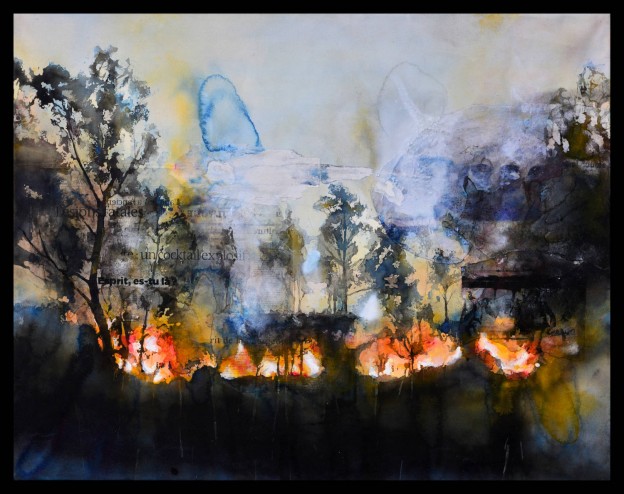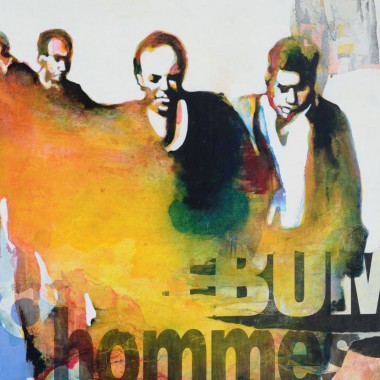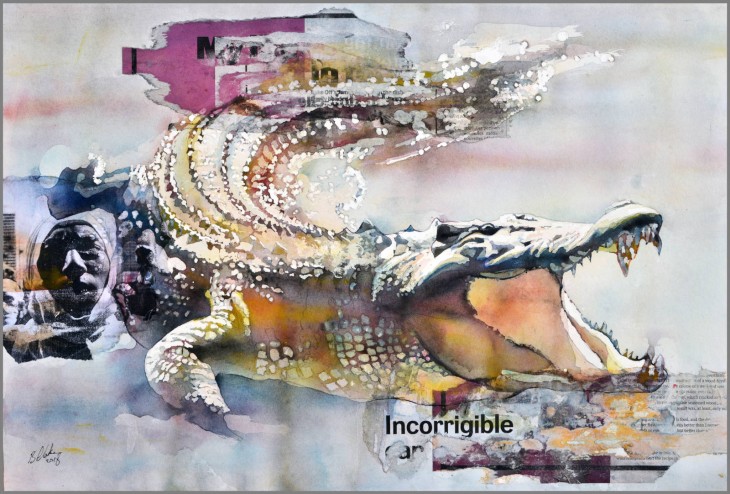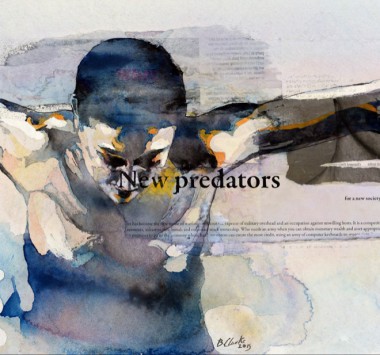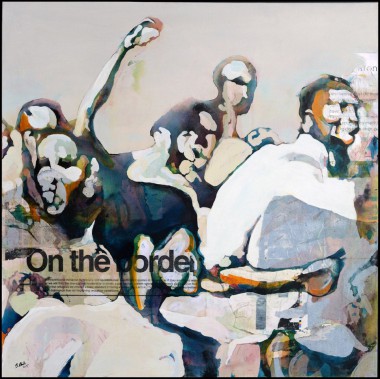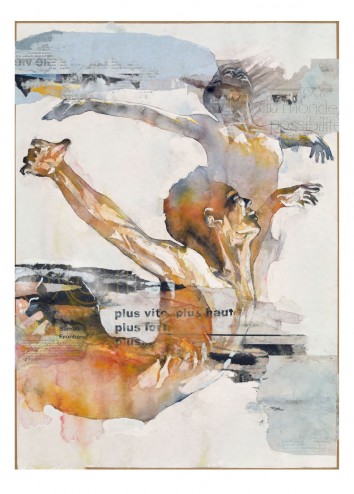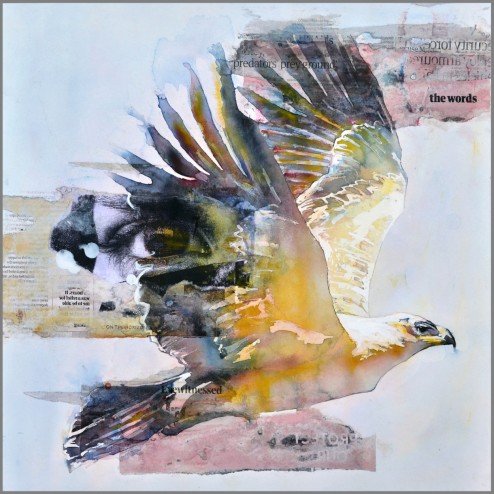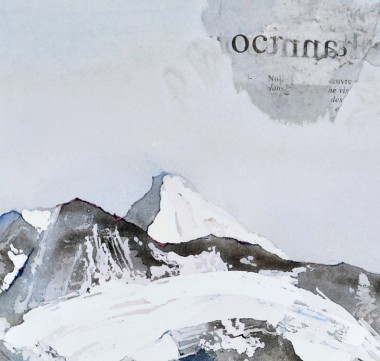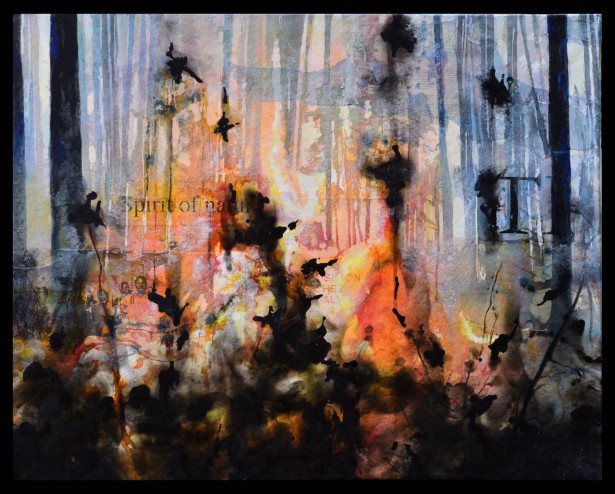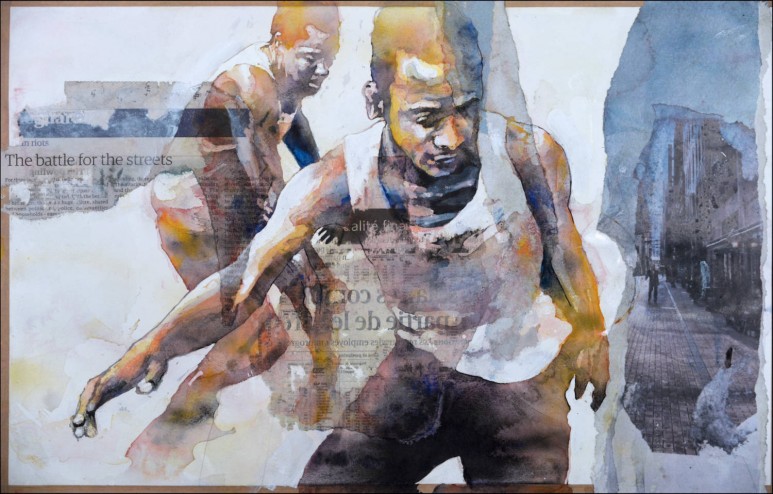About Bruce Clarke :
A visual artist and photographer, Bruce Clarke was born in London in 1959 to South African parents in exile. He has been living in France since the early 1990s.
In the 1980s, he studied at the Fine Arts department of the University of Leeds, where he was introduced to the Art & Language movement led by Michael Baldwin, David Bainbridge, Terry Atkinson, and Harold Hurrell. His work explores contemporary history, its narratives, and the transmission of these stories, aiming to provoke reflection on the modern world and its representations. Firmly rooted in a current of critical figuration, his artistic research incorporates established codes, only to subvert them against systems of power and injustice.

Of South African heritage through his parents, Clarke was politically and artistically committed from an early age to advocating for change in South Africa. He was one of the leaders of the National Rally Against Apartheid, an anti-apartheid movement in France. At the same time, he closely followed the developments of the Rwandan war and the warning signs of the genocide. After conducting a photographic report just weeks after the genocide in 1994, he proposed the creation of Le Jardin de la Mémoire (The Garden of Memory), an artistic memorial in the form of a monumental installation near Kigali. This project was carried out with the support of the victims' families, Rwandan institutions, UNESCO, and civil society. In Rwanda, he also worked on a project for the 20th commemoration of the genocide in 2014, Upright Men (Les Hommes Debout): www.uprightmen.org. This project has since been exhibited globally in over 20 exhibitions (Geneva, Lausanne, Brussels, Paris, Ouidah in collaboration with the Zinsou Foundation, Montreal, etc.). It is now permanently installed in Brussels and Kigali and was reimagined in 2024 as Les Femmes Debout (The Standing Women).

As an artist-in-residence invited by the General Council of Guadeloupe, Clarke created the exhibition Fragments of a History of Tomorrow, which examines the links between slavery, colonialism, and globalization. He collaborated with Fest’Africa in Lille on the project Rwanda: Writing, Filming, Painting in the Name of Remembrance, worked with the Afrika Cultural Centre in Johannesburg, and led art workshops in South Africa, Ethiopia, Rwanda, Benin, Tanzania, Zambia, and France.
Clarke has published Dominations (Homnisphères, 2006) and Fantômes de la Mer (Ghosts of the Sea) (ARTCO, 2016). Fantômes de la Mer documents an artistic project paying tribute to economic and political refugees who fell victim to trans-Mediterranean human trafficking.
As a photographer, he has published reports on South Africa, Rwanda’s reconstruction, the return of Liberian refugees, and Palestine.
In 2022, he was invited to exhibit in the two European Capitals of Culture, Esch in Luxembourg and Kaunas in Lithuania. In 2024, his work was showcased at the Memorial Foundation of Camp des Milles in France.
An active commitment
"Our humanity demands that we give, even it be in the space of a brief instant, face, name, voice and living memory to the hundreds of thousands of victims so that they aren’t merely synonymous to numbers, or worse still, thrown into the depths of forgetfulness or at best left sleeping in a few tables of statistics more or less officially recognised by the consciousness, which we call collective."
(Abdourahman A. Waberi, Moisson de crânes, (Harvest of skulls) Texts for Rwanda, p. 17).
No artist is isolated from his socio-political environment. His or her activity as a visual artist is, in itself a commitment, a critical commentary on the world. For Bruce Clarke his artistic work is inseparable from his political activism, firstly in relation to South Africa where he played a role on the anti-apartheid movement in France and with the ANC (African National Congress). He continues working on cultural projects in this country, particularly with the Afrika Cultural Centre in Johannesburg.
In the early 1990 s, Bruce Clarke closely followed, with his exiled African friends in Paris, the evolution of the war in Rwanda and the first signs of the genocide before coming face to face with the horror in August 1994 when he travelled on behalf of a collective of associations with which he was working, protesting against the open preparation of genocide. Thus was born the first ideas for the “Garden of Memory” which was enthusiastically welcomed by the institutions and civil society associations in Rwanda and which goes well beyond a simple artistic production. It is a project in progress close to Kigali.
"At that point, I began to reflect on the period after genocide. What role can an artist play in the preservation of real, living memory? Can he contribute to the psychological reconstruction of a totally traumatised population? With this project we had to make the reality of genocide tangible. What was left after the genocide, what we could see, wasn’t human anymore. It was a sort of abstraction: bones, mummified bodies. But these people had really existed; they had been people like you and me, who had a life behind them, a life now completely annihilated."


Notre Dame - ParisUNESCO - Paris
"That was the beginning of my reflection. Genocide had taken place in Rwanda. Approximately one million people had been killed. But each person killed had been an individual, with a face, occupying space. Wole Soyinka, the Nigerian writer has said that when a person is killed, it’s a tragedy, but when a thousand people are killed, it’s only a statistic. That’s what had to be avoided at all costs. It was fundamental to give back faces and individuality to the victims of tragedies, such as those in Rwanda, Palestine or elsewhere in the world. So the project, the Garden of Memory came out of a reflection on the way in which an artist can intervene in a very real situation. I had two principal preoccupations at the beginning of the project: How to take into account the enormity of what a genocide is – up to a million people killed. And at the same time it was essential to give a sense of humanity to each victim."
"As a foreign artist, I didn’t feel that I had the right to work with such sensitive material as human remains. I didn’t want to deal with it from that point of view, for obvious reasons. Distance had to be maintained. But how do you take distance as an artist? I thought that the distance could be found through inanimate matter – stone – which is abstract and at the same time full of symbolic meaning. That’s how I decided that the basic material for the Garden of Memory would be stone. But the garden wasn’t destined to be a place evoking horror; it had to be a place of contemplation. Where people could come and stroll. A garden is a place of renaissance; it isn’t a cemetery, or a place of death, even if it’s very pregnant with meaning. Besides this, the realisation of the project had to be done in strict collaboration with Rwandese civil society: the survivors, the women’s associations…"
"The Garden of Memory is a collective work. Even if the conception is mine, the project wouldn’t have any meaning if there wasn’t large scale participation in its realisation, or if the people involved didn’t fully understand the project and adhere to its ideas."
"The basic concept is very simple: it’s an individual act of memory in remembrance of an individual victim. This individual act is accomplished by a relative or close friend of the victim. The individual act is the posing of a stone with a mark on it. The person who puts the mark on the stone isn’t obliged to explain the mark to anyone. The mark can be a name or something abstract, but it must be an inscription in memory of a victim. Such an individual act of memory could be seen as a cathartic process opening the moment of mourning. So it’s this individual act of memory that we want "quite simply" to multiply by a million; make up a collective work composed of a million stones, each one being individualised and posed by someone close to the victim of the genocide. Posed according to a geometric schema that will evolve with time."
The Garden of Memory was first inaugurated on the 5th June 2000 in an important cultural manifestation, Fest’Africa in Rwanda. It is an on-going project.
How can art influence or comment on the course of history?
This is the principal and basic question that the Bruce Clarke, as a visual artist is asking himself through his life and work.
Text : Michèle Baj-Strobel
Solo exhibitions (selection)
2024 Au bord du Volcan Galerie Art-Z, Paris, France
2024 Vies d’Après : L’Artiste face au génocide des Tutsi, Fondation mémorielle du Camp des Milles, Aix en Provence, France
2024 Mémoires Invisibles, Espace Jean de Joigny, Joigny, France
2024 Les Femmes debout, Kigali, Rwanda
2023 Ecce Natura, ARTCO Gallery, Berlin
2023 E PLURIBUS UNUM, Kloser Contemporary Art, Belgique
2022 Ecce Homo, Those who stayed, IX Fort, Kaunas, Lituanie
2022 Ecce Homo, Musée national de la Résistance, Esch, Luxembourg
2022 Un Etat des Choses, Galerie Art-Z, Paris
2021 Walking the Line, ARTCO gallery Berlin
2020 Invisible Memories, Centre d’Art de Bonneuil
2019 En Suspension, Maison Rouge, Cotonou, Bénin
2019 Voices, Galerie Carole Kvasnevski, Paris
2019 Fantômes de la Mer, Alliance française Johannesburg
2019 Predators and Other Friends, Galerie Art-Z, Paris
2019 Lifting the Veil, Théâtre royal de Marrakech, Maroc
2018 Birth of an Icon, Kloser Contemporary Art, Anvers, Belgique
2018 Front Line, Espace Anis Gras, Arcueil
2018 Alliance française de Lusaka, Zambie
2017 Fantômes de la Mer, ARTCO Gallery, Aix-la Chapelle, Allemagne
2017 New Horizons, Cloître des Billettes, Paris,
2017 Mémoires vives et Hommes debout, Musée de Coutances, France
2016 Les Fantômes de la Mer, Institut français, Nouakchott, Mauritanie // Saint Martin, France/Antilles //, Île de Gorée, Sénégal
2015 Le travail rend libre, Galerie KO 21, Paris
2015 Daily Violence, Médiathèque de Lormont, France
2014 Galerie Art-Z, Paris
2014 Humanities Gallery Out of Africa, Sitges, Barcelone, Espagne
2014 En toute impunité, Les Naufragés du Temps, St Malo, France
2014 Les Hommes debout, exposition simultanée dans les villes de Kigali, Lausanne, Genève, Bruxelles, Paris, Limoges, Liège, Ouidah, Ivry, Lille….
2013 Precarious Lives, Galerie Julio Gonzalez, Arcueil
2013 Janus Gallery, Montreux, Suisse
2013 M.I.A. Gallery, Seattle, Etats-Unis
2012 Artium Gallery, Luxembourg
2012 Fondation Zinsou, Bénin
2011 Who’s Afraid , Musée des Arts Derniers, Paris
2010 Abbaye de Neumünster, Luxembourg
2010 Bekris Gallery, San Francisco, Etats-Unis
2002 Fragments d’une histoire de demain, L’Artchipel, Basse-Terre, Guadeloupe
2000 Je vous écris du Jardin de la Mémoire - Installation, Galerie Porte 2a, Bordeaux, France
1999 Centre Culturel Français, Kigali, Rwanda
1997 Ambassade d’Afrique du Sud, Paris
1997 Musée de Romans, Romans, France
Group exhibitions (selection)
2019 Urban Art Fair, Paris
2018 Art Paris 2018, Grand Palais Paris
2018 Fusions, Bordeaux, avec Migrations Culturelles 2a (MC2a)
2017 Galerie Vallois, (avec l'artiste Aston) Paris,
2017 AKAA Art Fair, Paris
2016 Tribute to Dak’Art, Martigny, Switzerland
2016 Sea Ghosts, Subabiennale, Dak’Art Off, Senegal
2016 Targets, ArtCo Gallery, Aachen, Germany
2016 Cape Town Art Fair, Le Cap Johannesburg
2015 Africa/Africains, Museu Afrrobresil, Sao Paolo, Brazil
2015 Global Topics, ArtCo Gallery, Aachen, Germany
2014 FNB Art Fair, Johannesburg
2013 Etonnants Voyageurs Festival, Saint-Malo, France
2012 Iwalewa Haus – Bayreuth, Germany
2012 Boxe Boxe, Fondation Blachère – Apt, France
2010 Couleur Café Festival, Bruxelles, Belgium
2009 Africajarc Festival, Carjac, France
2008 Musée des Arts Derniers, Paris, France
2008 Contemporary Art Fair, Espace Pierre Bergé, Bruxelles, Belgium
2007 East African Biennale, Dar es Salam, Tanzania
2004-5 La Galerie.be, Bruxelles, Belgium
2004-5 Musée des Arts Derniers, Paris, France
2004 Ephémère Gallery, Montigny-le- Tilleul, Belgium
2003 L’Essor Gallery, Le Sentier, Switzerland
2002 Dak’art Biennale, Dakar Senegal
2001 Belfort Art and History Museum - with Edith Convert, Belfort, France
2001 The Artist and the Real, Maison de la Culture de la Nièvre, Nevers, France 1998 Kulturfabrik, Luxembourg
1995 Africanités, Saintonge Gallery, Paris, France
1995 art’CRA, Accra, Ghana
1994 De l’Afrique à l’Afrique, Gallery Yahia, Tunis, Tunisia
Public collections
- Zinsou Foundation, Cotonou, Benin
- Contemporary Art Museum, Ouidah, Benin
- Blachère Foundation, France
- Tilder Foundation, France
- Artocarpe, Guadeloupe contemporary art museum, France
- Cities of Paris, Bordeaux, Bègles, France
- Museum for Palestine, UNESCO, Paris
Press kit


